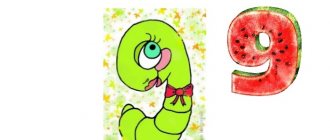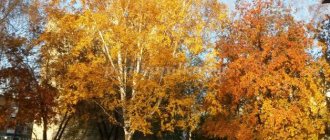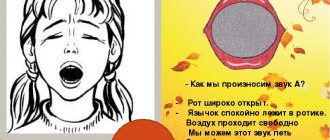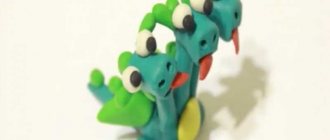Number three verses
***
Fluffy treated his girlfriend, the Bug-Eyed Frog. "I am not greedy. Here - take it. There are exactly THREE nuts here."
*** Larisa stands at the board, a girl in a fluffy skirt, and translates good deeds into glasses. The chalkboard is all in numbers. - For helping my mother - two points, For helping my baby brother I write a point to Nikitin, And to Gorchakov three points - He took the old man to visit. “Three points are not enough for this!” Andryusha Gorchakov shouts and jumps up from the bench. “Three points for the old man?!” I demand a raise! I spent almost half a day with him, He managed to fall in love with me.
Riddles about the number 3 for children
Does your child count well and can recognize different numbers visually without problems? And how well will he be able to guess the numbers from the artistic image he proposed, from the descriptions, which can be understood by using logic? Check it out with our cool puzzles.
You can use the collection of riddles about the number 3 for children presented on this page completely free of charge. Short, exciting tasks with answers are suitable for both boys and girls.
so UNT / Preschool education / Technological map of organized educational activities for the senior group
“Number and figure 3. formation of number 3
11/26/2015 5587 0 Alla Vladimirovna Privalova Date: 11/5/15 Technological map of organized educational activities for the senior group Educator: A. V. Privalova Educational area: Cognition. Section: FEMP. Topic: “Number and figure 3. formation of the number 3” Purpose: to practice counting to 3, to introduce the formation of the number 3 and the number 3; show the child using specific material that the number 3 is 2 and 1; learn to count objects within three; learn to correctly recognize and depict the number 3; develop logical thinking and memory; cultivate perseverance and independence. Equipment: leaves (3 pcs.), triangle, counting material for each child. Bilingual component, multilingualism: үш – three – three [θri:].
Stages of activity Teacher actions
Children's actions
Motivational and incentive 1. Game “Associations” (what do you want to say when you hear the word “Autumn”) The teacher names a tree, and the child names a leaf from this tree (birch - birch). 2. Conversation about the time of year. – What time of year is it? (Autumn) - Guys, look at the picture, what is the weather like here? – What color are the leaves in autumn?
-What does the wind do to the leaves? -What do leaves do? Play games with the teacher.
- Autumn.
Children's answers. - Red, yellow, green. - Plucks from trees. - They are flying and circling.
Organizational - search 3. - Guys, suddenly the wind blew, he invites the children to help the wind - to blow. The teacher shows two leaves of the same color: - What did the wind bring? – How do you find out how many leaves there are?
– The wind blew again, bringing another 1. The teacher demonstrates the formation of the number 3 (two and 1 more).
4. Exercise on tables. - Put a square, another square. - How many squares are there? - Put another one. - Now how much is it? 5. View number 3. Bilingual component, multilingualism: үш – three – three [θri:].
The history of the number. Guys, many of you already know how to count, you can count your toys, your friends, the trees in the garden, and much more. And in ancient times, people learned to count to two with great difficulty. Every time something unknown and mysterious began after the deuce. when they counted “one, two, many” or “all”. And only after many, many years they began to count to 3. The number 3 became the most favorite number, even in fairy tales. And what fairy tales will I wish for you now? 6. Riddles Oink-oink-oink - which three brothers are no longer afraid of the wolf, Because that predatory beast will not destroy a brick house.
There are three cups and three beds, There are also three chairs, look, And there are actually exactly three residents living here.
7. Physical exercise. "The Three Bears The Three Bears were Walking Home
Dad was big, big.
His mother is shorter than him, and his son is just a little baby. He was very small
He walked around with rattles.
Ding-ding, ding-ding.
8. Independent work of children. Working with counting sticks. - Read a series of numbers in order: 1,2,3. - What geometric figure is this? — What do we know about the triangle? - How many sticks do you need to take to build a triangle? 9. Let's open the notebooks and count the whites. The number is denoted by the number 3. Let's find the number 3. Let's circle the number 3: first along the upper rounded line down, then along the lower rounded line down. Let's write it in the air. And now on the floor with your feet. Now take a pencil and trace it in your notebook.
Blowing.
- Leaves. - We need to count. The child counts: “One, two - only two.” The child counts, names how many there are, and shows the same number of fingers on his hand.
Repeat after the teacher in Kazakh and English.
- Three piglets.
- Three Bears.
The children waddle in place. Raise your hands above your head, pull up. Hands at chest level. Sit down. Crouching and swinging like a bear. Stand up with your hands clenched into fists in front of your chest. Children imitate playing with rattles.
- Triangle. — There are 3 corners.
- Three.
They count the proteins.
Circle the number 3.
Reflexive-corrective Sums up. Thanks for the work.
He asks what number did they find out today? What number does it represent? Praises children for their work. For control, he suggests completing task 3. Stick the desired number. Summarize.
Shows the completion of work in a notebook. Expected result Know: number and figure 3. Have: an idea of writing the number 3. Be able to: find a group of three objects, recognize the number 3.
Visual aids
A presentation or photo can brighten up a lesson if you are in 1st grade, or diversify classes in kindergarten. The presentation will help children quickly remember what the number 3 looks like, what it looks like, and what it means. The presentation contains interesting photos of objects. You can lay out the photos in front of the child and ask them to count their number. Photos will also help if you need to figure out what a number looks like.
So, give your kids more creative activities, even if they involve something as dry and pragmatic as math . You can also find an element of novelty in numbers.
What does the number 3 look like?
To help a preschooler or a child who goes to 1st grade remember the number 3, a question can be asked: what does it look like? To answer it, give your child clues in the form of a riddle or numbers in pictures. In folklore genres, associations are often made between numbers and objects and phenomena. For example, a three is similar to a hook, half an eight, etc. If your child still cannot draw a parallel, help him by showing him photos of various objects.
Coloring books can provide an opportunity to master numbers not only for preschoolers, but also for children attending 1st grade. It not only teaches colors and numbers, but also develops perseverance and attention. The coloring book will also help the child answer what the number 3 looks like. The coloring book, printed from our website, can be an addition to the lesson or can be used as a task for a moment of relaxation. A coloring book can have many functions. If you are unsure what to give your preschooler homework after class, coloring will help you! Also, the coloring book may contain parallel comments and tasks of a different type (count and color, collect objects and color, etc.).
Count how many bears are in the picture.
You can offer your child a book about numbers in pictures. A colorful presentation can also be helpful. It is also perfect for teachers who teach children in 1st grade. A presentation with a commentary in Russian will give the children the opportunity to build an associative series with numbers. The presentation may contain some photographs of objects and phenomena associated with the number 3.
You should also remember that there is also the Roman numeral 3. This number can also be represented in pictures.




